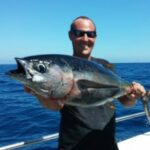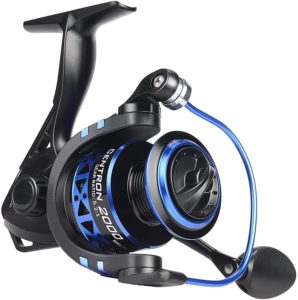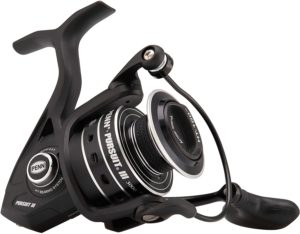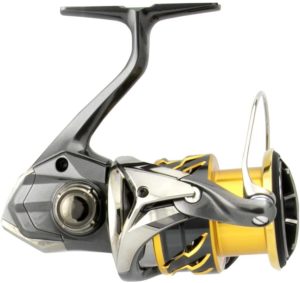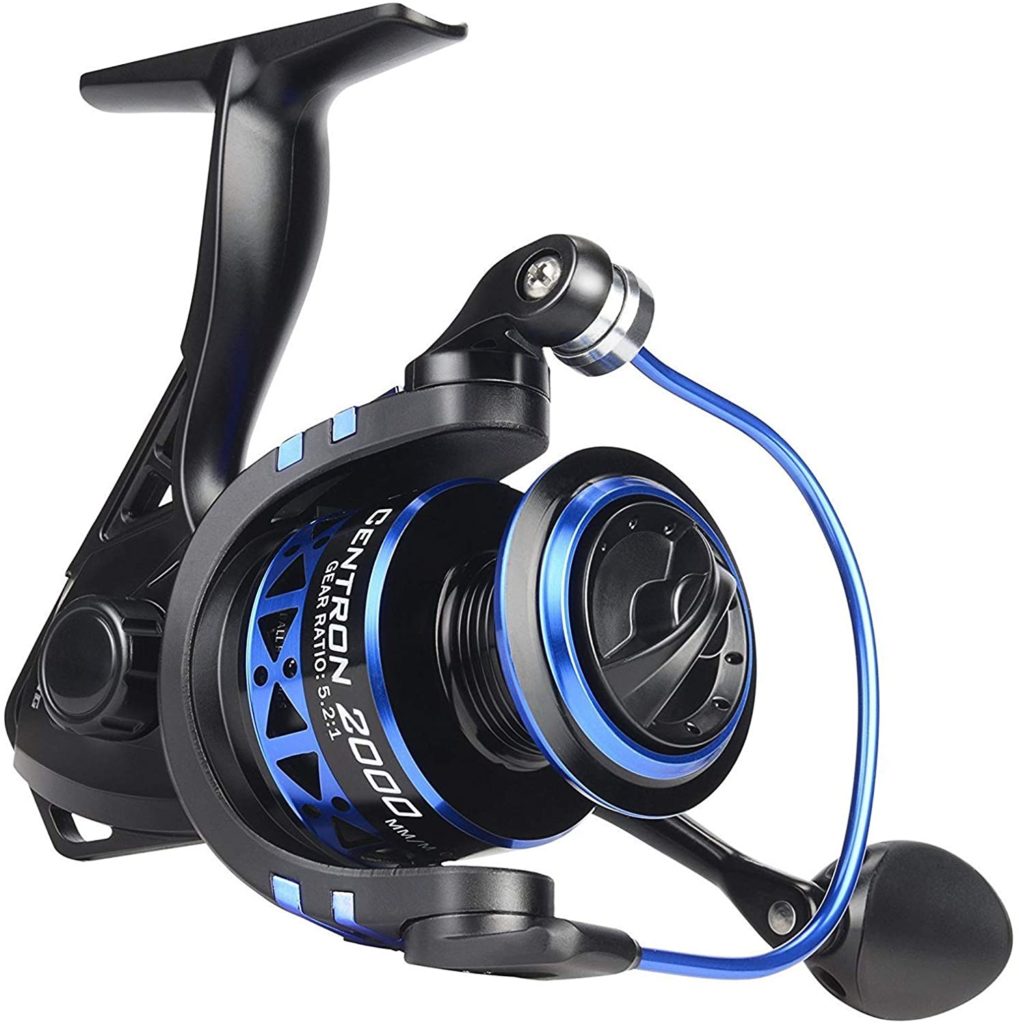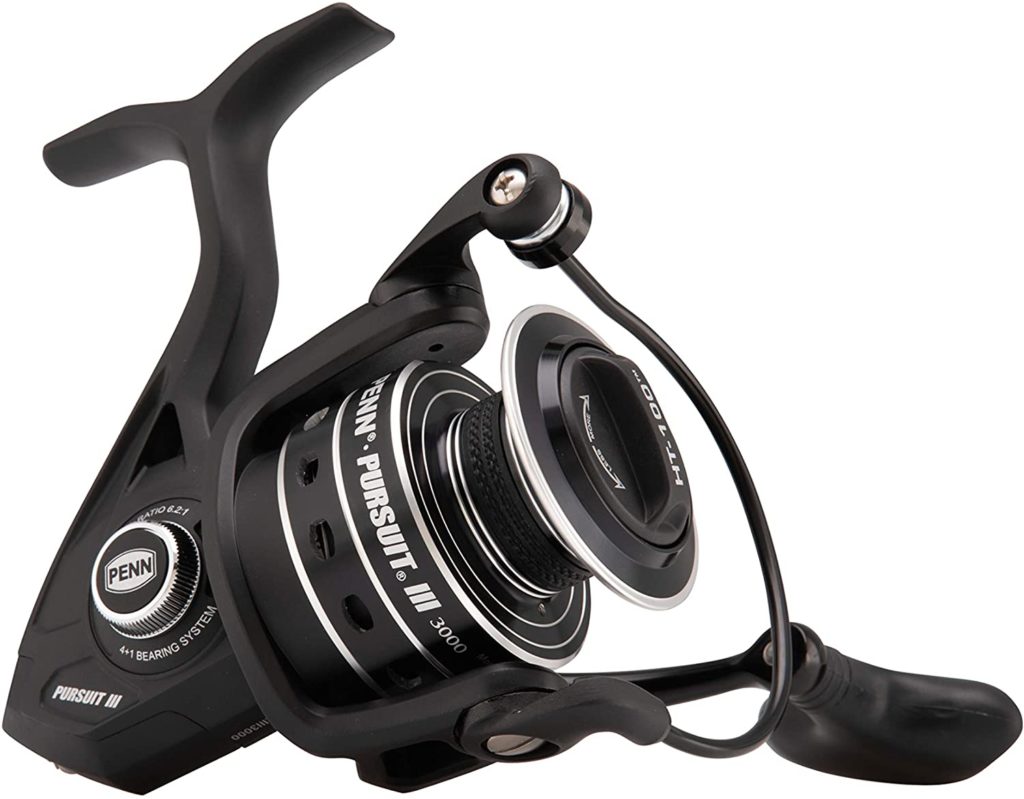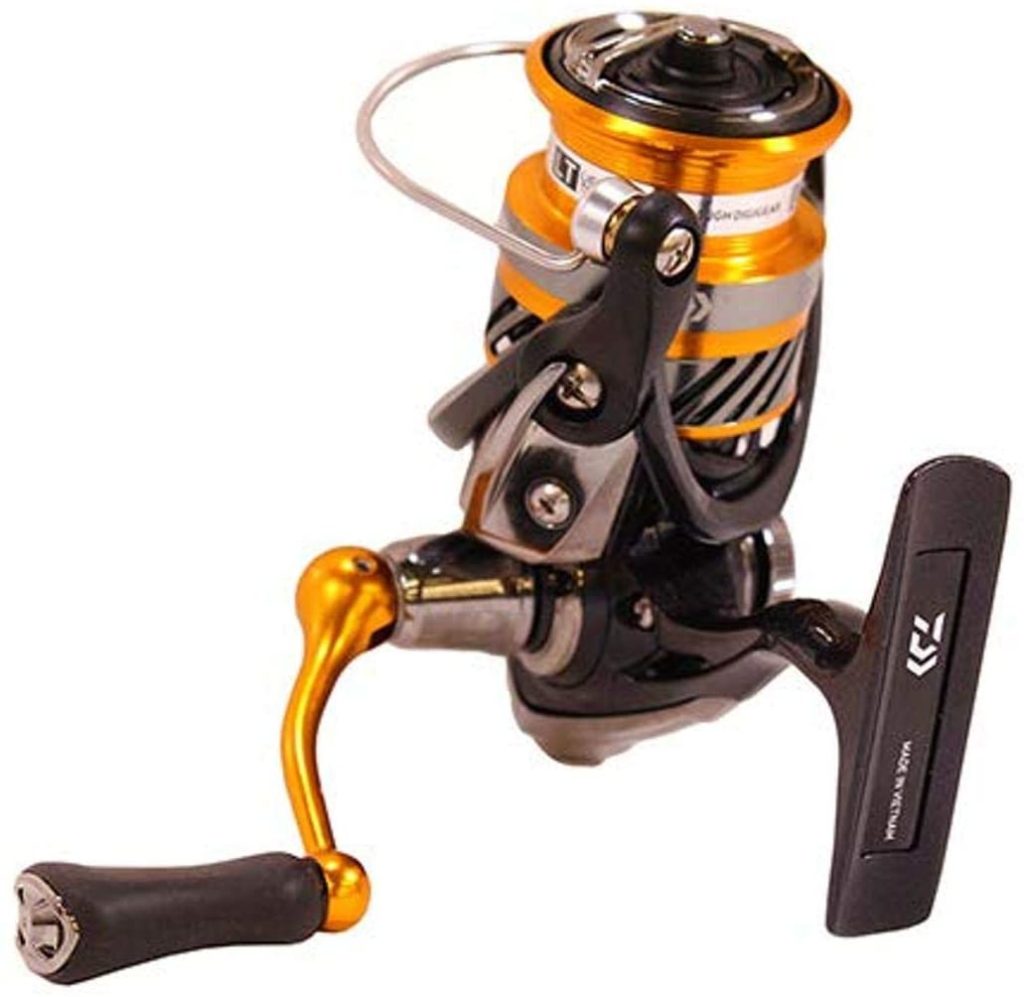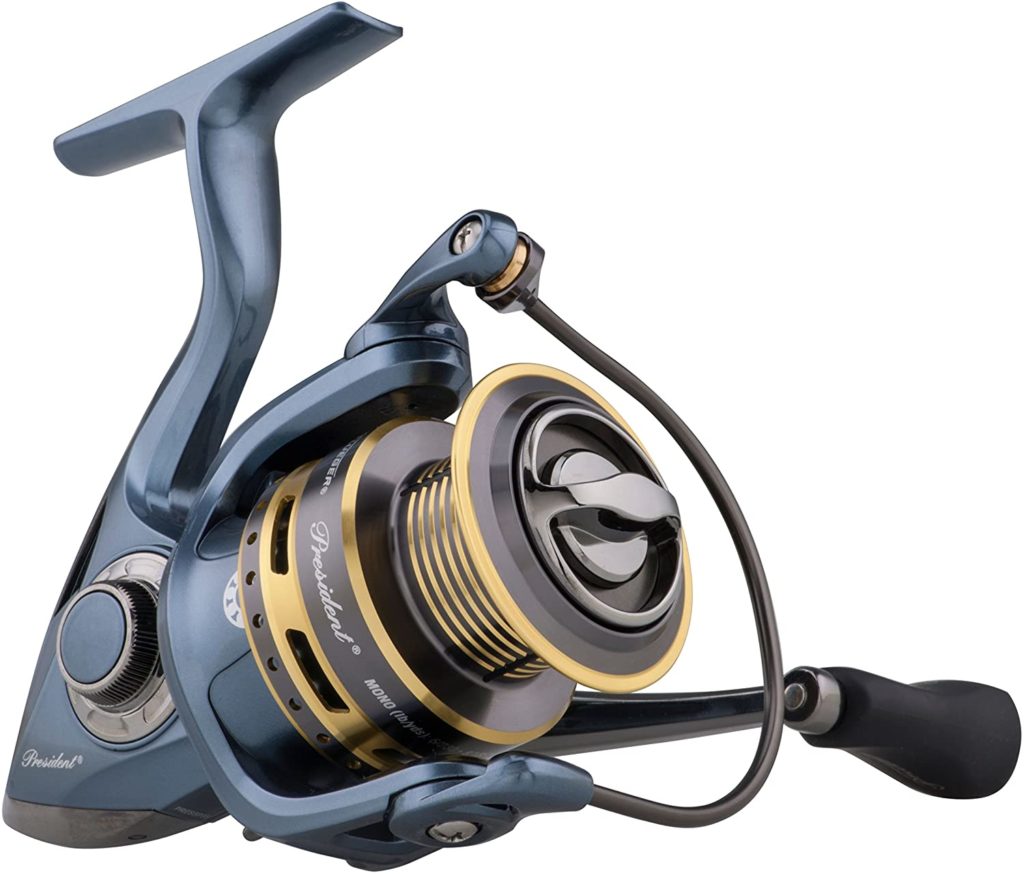I’ve been bass fishing my whole life to greater or less extent and success. I love every kind of fishing there is, but there really is nothing quite like slapping the banks of your local reservoir for a small mouth or dragging a texas rig through the lily pads in hopes of catching that lunker largemouth you know is there waiting to strike.
There are a ton of different techniques for bass fishing, and for every method, there are tools for the job. One of my good friends is a pro bass fisherman out here, shiny boat and all, and one thing we both agree on is that one of the essential tools for all the bass jobs is using the best bass spinning reel.
Best Budget
KastKing's Centron is the top choice in affordable spin fishing bass reels. An aluminum graphite composition, an excellent drag rating, and a smooth performance will have you feeling like a pro, even on a budget.
Check Today's PriceAlthough Kastking has spared the expense on this one, they’re not sparing the performance. With a CNC machined aluminum spool and a patented launch tip, KastKing has delivered a balanced reel that you can expect to cast like a dream. Add in its lightweight maneuverability, and you can expect to be skipping lures under docks with this one in no time.
This reel comes with 9 bearings and 1 instant stop reverse bearing. That means it will feel as smooth as a more expensive counterpart.
Keep in mind that affordability comes with some downsides. The reel is well built for the price, but some components, like the drag knob and drag linkage, may not last as long as those found on a more expensive counterpart.
Best Price to Quality
PENN Pursuit III is a reel for the serious bass fisherman looking for a reasonably priced reel. Its lightweight full graphite composition, slow oscillating gearing, and sealed drag system featuring carbon fiber drag washers has this reel outperforming its price and then some.
Check Today's PricePENN Pursuit III is an affordable saltwater reel you’ll love for freshwater bass fishing. Designed with salt in mind, PENN offers a full graphite, corrosion-resistant design with a sealed drag system.
That corrosion-resistant design means this reel is considerably lighter than a similar-sized aluminum reel, making it perfect for a day finessing bass into the boat. Also, the sealed saltwater drag system means that you can expect a smooth cast and retrieve trip after trip, even in freshwater.
Keep in mind that because this reel is designed for salt, although it’s super light, it is a little on the bulkier side.
Best Premium
Shimano has put together a high-end, strong, and smooth as butter reel. With its front drag design, silent-drive water repellant gearing, and titanium coated spool, the Twin Power Fd comes with some of the best reel technology money can buy.
Check Today's PriceShimano is one of the most trusted brands in fishing gear manufacturing, and this reel is one of the reasons why. This smooth and strong reel has Shimano’s patented x-protect water system, and Shimano’s patented silent drive technology to start with, and too many features to end with to list.
The one-piece titanium bail and titanium coated spool ring mean that even though this reel is graphite-free, it’s as light as they come and easier to cast than most.
Best Overall
The strength to weight ratio on the Daiwa Revros is nearly as good as it gets. Everything about this reel is light, from a carbon housing to an air rotor system. Diawa finishes this reel off with a machined aluminum handle, adding the power right where you need it. Looking for a bass fishing reel that'll do it all? Look no further.
Check Today's PriceDiawa knows fishing reels and delivers with this excellent all-around competitor. Bass fisherman will love its lightweight, low-profile carbon design that includes a 15 percent lighter air rotor system for smooth, positive retrievals.
Even though this reel has only 4 bearings to shave weight, we think you’ll love the smooth, quiet drag those bearings deliver.
Keep in mind that all that weight shaving does come at the small cost of a shallower spool. So if you’re looking to fish deep or far with this one, think about throwing on a braided line with a long fluoro leader.
Also Recommended
The Pflueger President is a tried and trusted model. With 10 bearings and a sealed drag system, Pflueger offers components on this reel most anglers would expect to pay a lot more for. The reviews have been in for a while on this one, and it's a sure bet.
Check Today's PriceThe Pflueger President is a true fisherman’s reel with specs that far outweigh its affordable price. The 10 bearing setup and sealed drag system mean this reel is smooth on its cast and retrieves.
The President also comes braid-ready. Pair that with corrosion-resistant bearings, and this reel has the versatility a fishing generalist will love.
Keep in mind that although this reel has a few higher-end features, it may not last as long as its more expensive counterparts.
What makes a spinning reel great for bass?
Bass fishing (see also sight fishing for spring bass), like fly fishing, is the angling gift that keeps on giving. Step onto a bass boat, and you’ll see a good angler start reeling in lunkers in no time. What you don’t see is how the fisherman reads the water and changes his tactics as he goes, inducing that strike we’re all looking for.
There’s always something to learn or change bass fishing. That means having a reel you don’t need to change makes all the difference.
The benefit of a spinning reel for bass fishing is simple. A spinning reel allows the angler to do everything and then some with one setup. Whether you’re slapping banks or skipping docks, a properly lined spinning reel-rod combination takes your mind off the reel and puts it on the fish.
How to choose the best spinning reel for bass fishing
Looking at picking the perfect spinning reel for your bass fishing adventures? There are a few things you’ll want to keep in mind.
Material
All reel bodies are generally made of aluminum or another metal, graphite, plastic or a combination of all three.
As one would expect, aluminum or metal wins in the strength department and is generally more rigid. Because of this, most high-end reels come housed in aluminum or a combination of aluminum and other material. The best of these reels are machined and the less expensive are cast.
When considering a reel remember that although “nicer” aluminum is generally also heavier than its graphite or plastic counterpart. If weight is a large consideration you may opt for a lighter material.
In addition to being lighter, graphite is also naturally corrosion resistant. So, if you are looking for a reel to fish freshwater bass with but also occasionally take to the salt, graphite is your best bet.
You can also take care of your other reels from corrosion by applying marine grease to them.
Weight
Weight is one of those things that really comes down to personal preference. If you’re fishing open deep water, you can probably get away with a sturdier, heavier reel.
Fishing piers, banks, docks, and tight finesse applications? I find that in these situations, the lighter the reel, the better. A lightweight reel not only allows you to finagle your rod around and get that lure into hard-to-reach places, but it also keeps you fishing longer.
Size
Most reel manufacturers offer reel sizes in the categories of small (500-2000), medium(3000), and large(4000+).
Here’s that pro tip again: In most bass fishing cases, size that reel down and throw on some braided line. Bass fishing technology has come a long way. A recent trend in other fishing styles, like fly fishing for anything, has focused on the large arbor well-balanced reel. In bass fishing, if you’re doing it right, that’s not the case.
Braided line will last you the whole season. Pairing a small or medium reel with braided line and a fluorocarbon leader will work in just about every application. Check this article for the best braided fishing line.
Fishing deep? Use that small reel with braided line and a longer leader. Fishing shallow? Use that same setup with a short leader.
If you’re not fishing braided, a good bet is to think about the target species and rod you’ll be pairing the reel with. For most bass applications, that still means a small reel. However, if you want to target the occasional catfish or muskie, you should probably consider a medium-sized reel.
Gear Ratio
Your reel’s gear ratio determines how quickly your spinning reel will pick line up off the water when retrieving. So gear ratio will play a huge part, whether you’re pulling your line in for another cast, setting your hook, or dragging that rig in to entice a strike.
Most spinning reels these days offer a gear ratio of 5.2:1 to 6.2:1. For bass fishing, or really any fishing for that matter, you’ll want a gear ratio on the quicker side (the 6.2:1 end). Remember, it’s always easier to slow down a retrieve than to spin your handle more and speed one up.
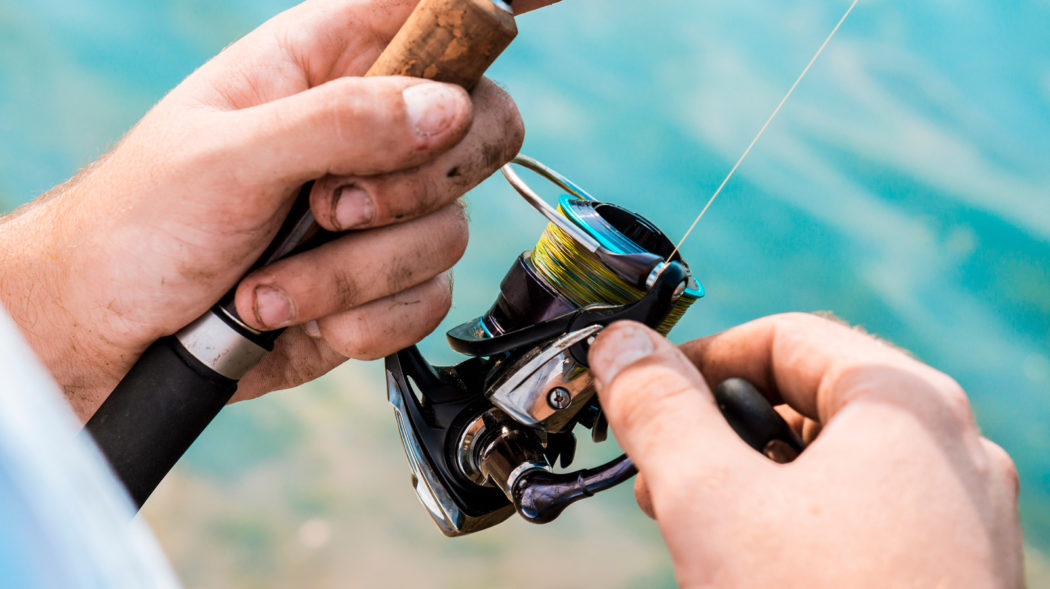
Line Capacity
Generally speaking, even a giant smallmouth or largemouth bass won’t run as far as other species you’ll be targeting.
Now I’m going to sound like a broken record here, but if you’re using braided line, and for bass fishing, you should be; line capacity won’t be much of an issue. Either way, though, it’s always good to know what your reel can handle.
If you do much deep sea fishing, think clear open water with a dropshot or tube bait, you’ll want a medium-sized reel with a bit of extra line capacity. If you do a lot of saltwater fishing, you’ll want even more room.
For most bass applications, though, you’ll be using a 4 to 10-pound mono or 5 to 15-pound braided line. With those line sizes, a small reel (size 2000) should be more than enough.
Drag Rating
Bass are hardy fish with hardy lips that can be brought to the boat or bank pretty quickly.
A good rule of thumb when setting your drag is to keep it at about one-third of the breaking strength of your line. For example, if you’re running 15 pound braided, that means your drag should be set at about five pounds. Running three-pound mono? You got it. Your drag should be set at 1 pound.
Even most small or inexpensive reels will have a drag rating of about 10 pounds. So if you’re doing the math here, even if you’re catching lunkers, finding a good drag-rated reel for bass fishing shouldn’t be too much of a problem.
Bearings
To keep it simple, I like to think the more bearings, the better. Most spinning reels will come with between 2 to 10 bearings. More and higher quality bearings generally mean a smoother, more predictable reel.
Anti-Reverse Switch
Anti-reverse on a spinning reel automatically engages the angler’s drag setting, stopping the reel from moving in reverse. Many spinning reels nowadays come with a switch, allowing the angler to choose to engage this feature or not.
This switch can come in handy when bass fishing if you hook a lunker or a species you weren’t targeting. If you don’t have time to move your drag or feel the drag is inadequate for the size fish, you can hit your anti-reverse and back reel the large fish.
When looking for a quality reel, an anti-reverse switch is definitely something to consider, though not always necessary.
Price
The price of a good bass fishing spinning reel runs the gamut. When thinking price, read the reviews and consider your application and time spent on the water.
In many cases, pairing a smaller reel with braided line will get you a bit better bang for your buck.
You’ll also want to consider the features you can’t live without. For me, those features are a smallerish size, high-quality construction, and a better than average bearing rating.
What size reel works best for bass fishing?
A lot of times, bass fishing is about finesse. Finesse style fishing means you’ll be looking for a reel on the smaller end, one that feels easy to maneuver and light in hand.
Looking for a pro tip? A lot of pro bass fishermen these days throw braided lines on the smallest spinning reels they can find. This is because pound for pound braided line is way stronger than mono and way smaller.
For example, 10-pound braided line is the same diameter as 2-pound test mono. That means, on a small reel, you can fit a lot more of it. An added bonus is that it also lasts longer.
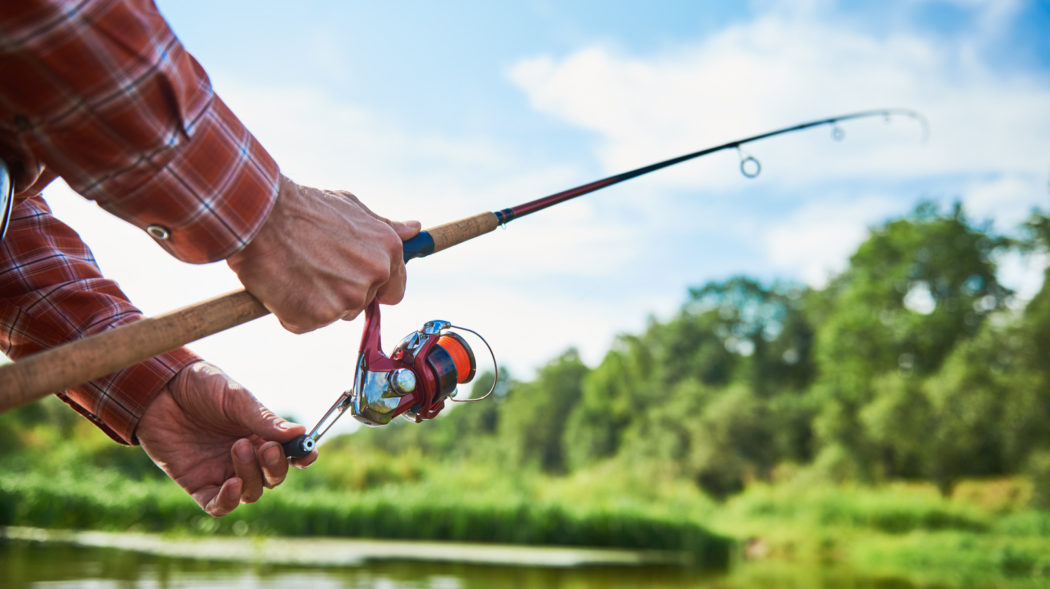
What benefits do spinning reels have over baitcasting reels for bass fishing?
The debate over a spinning reel and rod versus a baitcasting reel and rod for bass fishing is as old as time itself. Although in some applications, a baitcasting reel may be better (like if you are a professional tv fisherman with a perfect cast looking for a monster bass or muskie), the truth is that a spinning reel offers precisely what most anglers need.
What exactly do you need? Simplicity and a low learning curve, finesse, good value, and no dreaded backlash.
So, first of all, a spinning reel is just flat-out easier to use. Most guys learn to fish on a spincaster or spinning reel, and that’s because the technique is quite a bit simpler than the baitcasting technique.
And if you mess up the cast on a baitcaster, i.e., don’t time your cast perfectly with the line going out, you get backlash. Backlash is the baitcaster equivalent of a bird’s nest, but a lot worse. Think ten to twenty minutes working your line back tight on the reel.
Mess up the cast on the spinning reel, and you may have a small bird’s nest, but most likely, you’ll just need to set the bail, reel in, and recast.
Beyond the easy learning curve, spinning reels are also generally more affordable. Baitcasters are designed to sit on heavy baitcasting rods and throw heavy line and lures far. Because of this, they are built Ford tough and can cost an arm and a leg.
On the other hand, spinning reels can really do it all, even finesse fish, at a great value. With a do it all approach in mind, they are generally built more uncomplicated but sturdy and cost less money. So if you’re looking to catch more fish or to catch picky fish, and also not looking to break the bank, a spinning reel is the clear winner.
We also have an article here about the Inshore Spinning Reels.
Conclusion
The first time I stepped onto my buddy’s shiny purple flaked pro bass boat, I saw at least ten rods lining the bottom. He had baitcasters, spinning rods, and even a spincaster. I asked him why he had so many. He told me you never know what you’ll need…
Before reaching for his spinning rod.
As an Amazon Associate, Fishermen's Angle earns from qualifying purchases. We get commissions for purchases made through links in this post.
